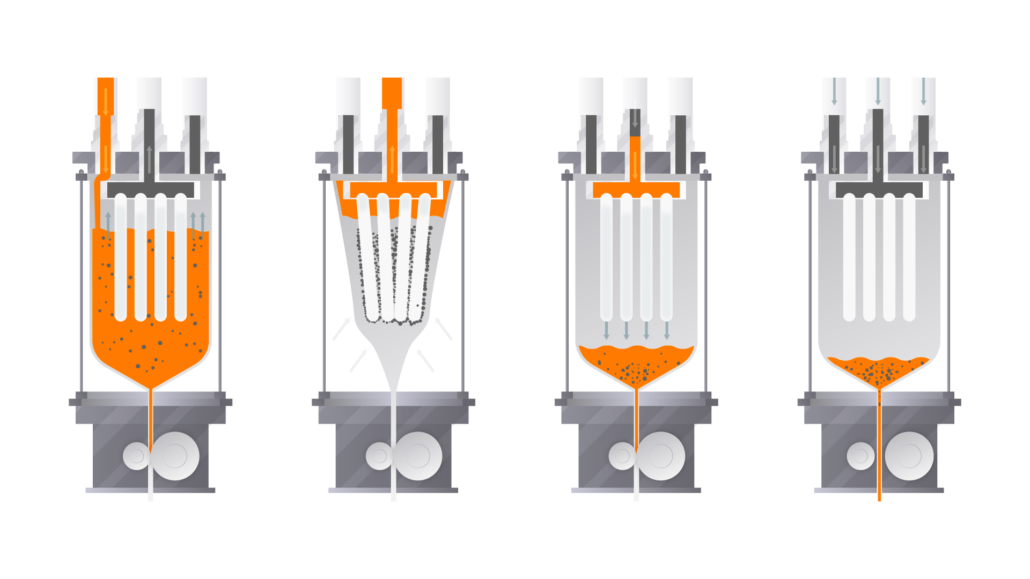FUNDALOOP: The Efficient and Compact Solution for Downstream Bottlenecks
In recent years, single-use (SU) technology has revolutionized bioproduction efficiency, especially with the introduction of disposable bioreactors in upstream processing. However, downstream processes such as cell harvesting and filtration continue to present bottlenecks in manufacturing.
Currently, typical clarification processes involve primary and secondary clarification steps, such as centrifugation followed by depth filtration, respectively. Although two sets of SU depth filters can be used for primary and secondary clarification, they tend to foul quickly and must be replaced. This increases not only operating expense, but also risk of contamination and plastic waste. To eliminate this bottleneck, DrM is introducing a new FUNDALOOP filtration technology, which combines primary and secondary steps in one unit operation.
The FUNDALOOP technology is the only single-use cyclical cake-filtration system available in the market. A backflush and filter cloth regeneration step is implemented after each cycle, providing a novel way to prevent fouling. When a SU filter clogs, it usually is considered to be spent and must be disposed of and replaced. The cyclical nature of the FUNDALOOP system provides users with all the benefits of disposable technology, such as contamination reduction and ease-of-use, while also prolonging the lifespan of one filter cloth for multiple cycles. Operating in cycles also provides space saving benefits, as one 30L filter bag can process 2000L+ of material, depending of culture density.
The filter technology is based on the addition of diatomaceous earth, which combines with cells and other process solids to form a porous cake. This cake is what actually performs the filtration while the filter cloth itself simply acts as a support for it. Unlike in a depth filter, the filter medium thus can be coarse and thin so as to not trap debris over time. The four main steps of a FUNDALOOP filtration cycle are shown in Figure 1. Four filtration elements covered by a filter cloth are surrounded by a multi-layer polyethylene film, creating a single-use multicycle sterilizable 30-L bag. The bag is connected to corresponding inlets, a filtrate outlet, and discharge hoses and is sealed airtight relative to the transparent vessel housing it.

Figure 1: The four main steps of a FUNDALOOP filtration cycle.
In the first step, cell culture fluid is pumped into the bag and filtered, creating a porous cake of solids on the elements. Once filtration has ended, heel-volume filtration is executed by introducing pressurized gas to the area in between the housing vessel and the plastic bag. That squeezes the remaining liquid through the filter elements and out through the filtrate line. Cake washing is an optional step to ensure that product remaining in the cake can be recovered. At this point, the filter cloth is regenerated by pumping a sterile liquid such as wash buffer, water for injection (WFI), or filtrate back in the opposite direction through the filter elements to dislodge the cake and other fine particles that may have become embedded in the cloth. Finally, the discharge valve opens so that remaining liquids and solids are discharged from the bag. This cycle can repeat up to 100 times.
Experimental results obtained at laboratory scale using a 200-mL Nutsche filter operated at a constant pressure of 1.5 bar showed that with cyclical function and cloth regeneration, a FundaLoop filter can maintain high flow rates.
Possible applications of the FundaLoop filtration system include the bioprocessing industry, where it can be used for clarification of recombinant proteins from CHO culture or separation of adherent cell lines from microcarrier beads. It may also be used for clarifying microbial culture, depending on cell density.
In conclusion, the FundaLoop filtration system has shown significant advantages over depth filtration in terms of flow rates, laboratory footprint, and filtration area. Compared to existing SU filtration techniques, our technology stands out due to its cyclical function and cloth regeneration, which can minimize fouling over time and improve overall efficiency and capacity. Additionally, the ability to combine primary and secondary clarification in one unit operation eliminates the downstream bottleneck, reducing the need for multiple filters and the associated costs.

